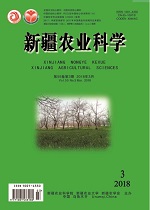|
|
Characteristics and Pedigree Analysis of Main Cultivated Varieties of Xinjiang Sea-Island Cotton (G.barbadense L.)
2018, 55(4):
589-600.
DOI: 10.6048/j.issn.1001-4330.2018.04.001
【Objective】 To fully understand the performance of Xinjiang island cotton varieties, explore its genetic basis, and provide support for further utilization of resources.【Method】From 2013 to 2016 years, 58 varieties of Xinjiang island cotton were identified by continuously centralized planting in the same ecological area, their characteristics and genealogical relationships were studied.【Result】The incidence of Fusarium Wilt with coefficient variation (CV) was higher in different varieties, and reached 89.2%. The fruit spur type was 48.6%, plant height (13.0%), first sympodial branch section (15.0%), boll number (18%), (10.7%) fiber strength and fiber yellowness (11.0%) coefficient of variation were higher, and other characteristics were lower (<10%). In addition to the 4 varieties of early bred cultivars, the varieties developed in different periods were of zero-type branch type. The average plant height, boll weight, seed index, fiber length and specific strength increased year by year. After 2010s, their growth was more rapid, 13.4and 9.7and 8.1and 5.5 and 9.8 faster respectively than those of the varieties of 2000s. The disease resistance to Fusarium wilt was significantly increased, lint percentage increased slowly and the floc color turned white. In recent years, the boll period of the main cultivar increased slightly, the number of bolls per plant and boll weight increased, and the disease resistance became stronger. From the pedigree point of view, the varieties of Xinjiang island cotton were mainly derived from the Egyptian type in Central Asia, in which 8763И, 5230Ф and 2И3, 9122И were mainly used to improve the varieties in Turpan Basin and Tarim Basin, respectively. The injection of breakthrough intermediate materials in different periods was the basis for the improvement of fiber quality and resistance of Xinjiang island cotton. The results of cluster analysis were consistent with pedigree analysis. 【Conclusion】The main economic characters of the varieties bred in Xinjiang Island Cotton in the past 10 years have increased rapidly, especially in the improvement of boll weight, fiber quality and disease resistance. The mainstay parents of bred varieties mainly come from the countries of Central Asia,with narrow genetic basis in their early varieties, but the genetic background of 2010s varieties is complicated. On the premise of high quality, high efficiency and sustainability, island breeding in the future should seek further ways to expand resource sources, tap germplasm potential, enrich variety types, and provide support for the development of island cotton industry of island cotton in Xinjiang.
|

